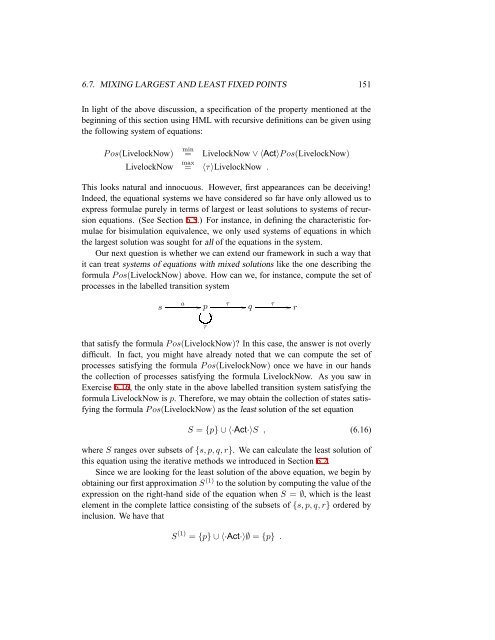Reactive Systems: Modelling, Specification and Verification - Cs.ioc.ee
Reactive Systems: Modelling, Specification and Verification - Cs.ioc.ee
Reactive Systems: Modelling, Specification and Verification - Cs.ioc.ee
Create successful ePaper yourself
Turn your PDF publications into a flip-book with our unique Google optimized e-Paper software.
6.7. MIXING LARGEST AND LEAST FIXED POINTS 151<br />
In light of the above discussion, a specification of the property mentioned at the<br />
beginning of this section using HML with recursive definitions can be given using<br />
the following system of equations:<br />
P os(LivelockNow) min<br />
= LivelockNow ∨ 〈Act〉P os(LivelockNow)<br />
LivelockNow max<br />
= 〈τ〉LivelockNow .<br />
This looks natural <strong>and</strong> innocuous. However, first appearances can be deceiving!<br />
Ind<strong>ee</strong>d, the equational systems we have considered so far have only allowed us to<br />
express formulae purely in terms of largest or least solutions to systems of recursion<br />
equations. (S<strong>ee</strong> Section 6.5.) For instance, in defining the characteristic formulae<br />
for bisimulation equivalence, we only used systems of equations in which<br />
the largest solution was sought for all of the equations in the system.<br />
Our next question is whether we can extend our framework in such a way that<br />
it can treat systems of equations with mixed solutions like the one describing the<br />
formula P os(LivelockNow) above. How can we, for instance, compute the set of<br />
processes in the labelled transition system<br />
s<br />
a <br />
p<br />
<br />
τ<br />
τ <br />
τ q <br />
r<br />
that satisfy the formula P os(LivelockNow)? In this case, the answer is not overly<br />
difficult. In fact, you might have already noted that we can compute the set of<br />
processes satisfying the formula P os(LivelockNow) once we have in our h<strong>and</strong>s<br />
the collection of processes satisfying the formula LivelockNow. As you saw in<br />
Exercise 6.16, the only state in the above labelled transition system satisfying the<br />
formula LivelockNow is p. Therefore, we may obtain the collection of states satisfying<br />
the formula P os(LivelockNow) as the least solution of the set equation<br />
S = {p} ∪ 〈·Act·〉S , (6.16)<br />
where S ranges over subsets of {s, p, q, r}. We can calculate the least solution of<br />
this equation using the iterative methods we introduced in Section 6.2.<br />
Since we are looking for the least solution of the above equation, we begin by<br />
obtaining our first approximation S (1) to the solution by computing the value of the<br />
expression on the right-h<strong>and</strong> side of the equation when S = ∅, which is the least<br />
element in the complete lattice consisting of the subsets of {s, p, q, r} ordered by<br />
inclusion. We have that<br />
S (1) = {p} ∪ 〈·Act·〉∅ = {p} .
















